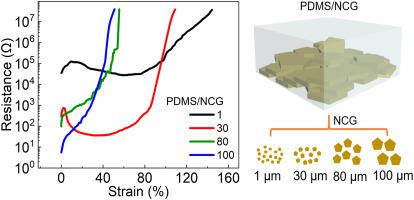Composites Science and Technology ( IF 9.1 ) Pub Date : 2021-09-15 , DOI: 10.1016/j.compscitech.2021.109037 Siqi Li 1 , Qian Liu 1 , Zhijian Sun 2 , Qingyan Liu 1 , An Lv 1 , Zikang Hu 1 , YaTing Xu 1 , Shasha Wan 1 , Hailong Hu 1 , Zhuohang Liu 1 , Xudong Fu 1 , Qingting Liu 1 , Shengfei Hu 1 , Rong Zhang 1 , Ching Ping Wong 2

|
Flexible strain sensing composites with tunable behaviors are widely required in fields such as telemedicine, wearable health monitoring equipment, and electronic skin. In this study, the sensing behaviors of flexible conductive polydimethylsiloxane (PDMS)/nickel-coated graphite (NCG) composites were easily regulated by adjusting the NCG size, in which the composites were prepared by a facile sedimentation method. The size of NCG particles has a significant impact on the sensing performances, including resistance change against strain and working range. When the size was small (1 and 30 μm), the resistance of PDMS/NCG slightly increased, then decreased clearly, and finally rose with increasing strain again. On the other hand, the resistance of PDMS/NCG increased monotonously with strain when the size was large (80 and 100 μm). The working range decreased with increments of filler size. Then, resistance of composites against strain was easily tuned by changing the content ratio of hybrid fillers with NCG of 30 μm and 100 μm. It was due to the competition between the resistance change along and perpendicular to the stretching direction which was proved by the morphology revolution and sensing performance of composites with hybrid fillers. The composite sensors could realize the detection of human motion. The results show that the controls of filler size and synergy effects of the hybrid fillers with different sizes are efficient ways to regulate the sensing behaviors of flexible sensors.
中文翻译:

柔性导电 PDMS/NCG 复合材料通过调节填料粒径的可调传感行为,通过简易沉降法制备
远程医疗、可穿戴健康监测设备和电子皮肤等领域广泛需要具有可调行为的柔性应变传感复合材料。在这项研究中,柔性导电聚二甲基硅氧烷(PDMS)/镀镍石墨(NCG)复合材料的传感行为很容易通过调节 NCG 尺寸来调节,其中复合材料是通过简单的沉降方法制备的。NCG 颗粒的大小对传感性能有显着影响,包括电阻随应变变化和工作范围。当尺寸较小(1 和 30 μm)时,PDMS/NCG 的电阻略有增加,然后明显下降,最后随着应变的增加再次上升。另一方面,当尺寸较大(80 和 100 μm)时,PDMS/NCG 的电阻随应变单调增加。工作范围随着填料尺寸的增加而减小。然后,通过改变 NCG 为 30 μm 和 100 μm 的混合填料的含量比,可以轻松调节复合材料的抗应变能力。这是由于沿拉伸方向和垂直于拉伸方向的电阻变化之间存在竞争,混合填料复合材料的形态革命和传感性能证明了这一点。复合传感器可以实现人体运动的检测。结果表明,控制填料尺寸和不同尺寸混合填料的协同效应是调节柔性传感器传感行为的有效方法。这是由于沿拉伸方向和垂直于拉伸方向的电阻变化之间存在竞争,混合填料复合材料的形态革命和传感性能证明了这一点。复合传感器可以实现人体运动的检测。结果表明,控制填料尺寸和不同尺寸混合填料的协同效应是调节柔性传感器传感行为的有效方法。这是由于沿拉伸方向和垂直于拉伸方向的电阻变化之间存在竞争,混合填料复合材料的形态革命和传感性能证明了这一点。复合传感器可以实现人体运动的检测。结果表明,控制填料尺寸和不同尺寸混合填料的协同效应是调节柔性传感器传感行为的有效方法。


























 京公网安备 11010802027423号
京公网安备 11010802027423号